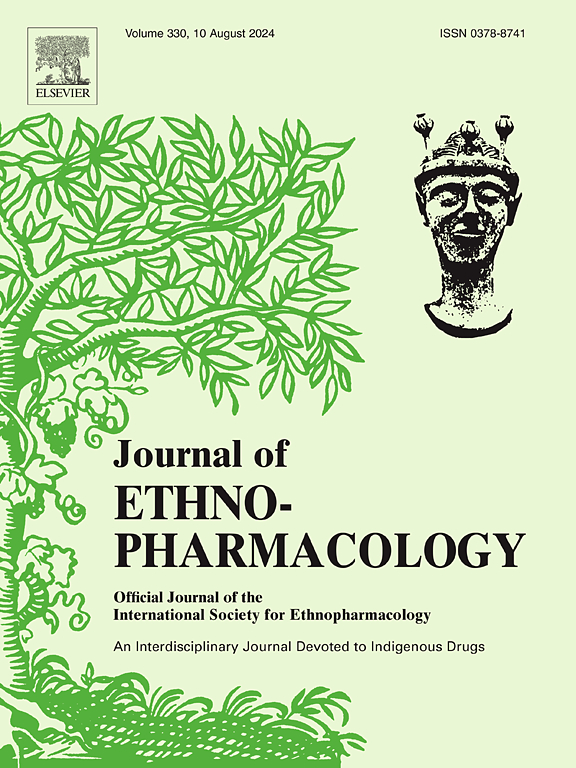Evaluation of the sedative-hypnotic effects of Menyanthes trifoliata L. extract in mice
IF 5.4
2区 医学
Q1 CHEMISTRY, MEDICINAL
引用次数: 0
Abstract
Ethnopharmacological relevance
Insomnia is a pervasive and prominent problem worldwide, afflicting approximately one-third of the population and profoundly affecting patients' quality of life. Efficient and safe sedative-hypnotic medications are required. Menyanthes trifoliata L. (Mt), a sleeping herb in China, is used as a hypnotic remedy in ethnomedicines; however, there are few studies on this herb.
Aim of the study
We systematically evaluated the potential of Mt as a sedative-hypnotic candidate.
Materials and methods
The chemical constituents of the Mt extract were analyzed by lLiquid chromatography with photodiode array detection and mass spectrometry (LC-PDA-MS). The sedative-hypnotic effects of Mt extract (0.5, 2, and 4 g/kg) were investigated using the pentobarbital-induced sleep test (PIST), the caffeine-induced insomnia model (CIIM), and the open field test (OFT). Furthermore, the effect of Mt on sleep architecture was investigated using electroencephalography/electromyography (EEG/EMG). The safety of the Mt extract was evaluated using the maximum tolerated dose method.
Results
Fifteen phenolic compounds were identified based on their UV absorption and MS fragmentation using LC-PDA-MS analysis. In the CIIM, PIST, and OFT, Mt extract exhibited a dose-dependent reduction in sleep latency, an extension of total sleep duration, and a decrease in locomotor activity. Moreover, it increased the duration of non-rapid eye movement (NREM) sleep and reduced wakefulness after one day's administration, according to EEG/EMG. Additionally, no signs of toxicity were observed at a dose of 30 g/kg (equivalent to 316.46 g/kg of crude drugs).
Conclusion
This study supports the potential medicinal use of Mt extract for sleep promotion.

三叶草提取物对小鼠镇静催眠作用的评价。
民族药理学相关性:失眠是世界范围内普遍存在的突出问题,折磨着大约三分之一的人口,深刻地影响着患者的生活质量。需要有效和安全的镇静催眠药物。三叶Menyanthes trifoliata L (Mt)是中国的一种睡眠草本植物,在民族医学中被用作催眠药物;然而,关于这种草药的研究很少。研究目的:我们系统地评估了Mt作为镇静催眠候选药物的潜力。材料与方法:采用液相色谱-光电二极管阵列检测-质谱法(LC-PDA-MS)对Mt提取物的化学成分进行分析。采用戊巴比妥诱导睡眠实验(PIST)、咖啡因诱导失眠模型(CIIM)和开放场实验(OFT)研究了Mt提取物(0.5、2和4 g/kg)的镇静催眠作用。此外,利用脑电图/肌电图(EEG/EMG)研究了Mt对睡眠结构的影响。采用最大耐受剂量法评价Mt提取物的安全性。结果:采用LC-PDA-MS分析,通过紫外吸收和质谱破碎鉴定出15种酚类化合物。在CIIM, ist和OFT中,Mt提取物显示出剂量依赖性的睡眠潜伏期减少,总睡眠时间延长,运动活动减少。此外,根据脑电图/肌电图,服用一天后,它增加了非快速眼动睡眠(NREM)的持续时间,减少了清醒时间。此外,在剂量为30 g/kg(相当于316.46 g/kg生药)时未观察到毒性迹象。结论:本研究支持山麻提取物促进睡眠的潜在药用价值。
本文章由计算机程序翻译,如有差异,请以英文原文为准。
求助全文
约1分钟内获得全文
求助全文
来源期刊

Journal of ethnopharmacology
医学-全科医学与补充医学
CiteScore
10.30
自引率
5.60%
发文量
967
审稿时长
77 days
期刊介绍:
The Journal of Ethnopharmacology is dedicated to the exchange of information and understandings about people''s use of plants, fungi, animals, microorganisms and minerals and their biological and pharmacological effects based on the principles established through international conventions. Early people confronted with illness and disease, discovered a wealth of useful therapeutic agents in the plant and animal kingdoms. The empirical knowledge of these medicinal substances and their toxic potential was passed on by oral tradition and sometimes recorded in herbals and other texts on materia medica. Many valuable drugs of today (e.g., atropine, ephedrine, tubocurarine, digoxin, reserpine) came into use through the study of indigenous remedies. Chemists continue to use plant-derived drugs (e.g., morphine, taxol, physostigmine, quinidine, emetine) as prototypes in their attempts to develop more effective and less toxic medicinals.
 求助内容:
求助内容: 应助结果提醒方式:
应助结果提醒方式:


